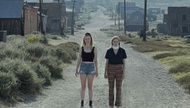This year I’ve watched my share of documentaries whose subjects are either boring and overblown (Gaga: Five Foot Two) or fascinating yet stretched too thin (78/52, about the shower scene in Psycho), but thankfully fall has welcomed a slew of docs that involve subjects both worthy and well-handled.
Given that HBO’s Spielberg centers on the world’s most successful film director, you’d think it would be chock-full of ego and hot air. But what’s so wonderful about the Spielberg in Spielberg is what a likable dork he is. One might eye-roll at the idea of Spielberg having struggles, but the man’s demons—his parents’ divorce, his critics, his relationship with religion—are relatable. Things do get a tad gassy in the final half hour (“Spielberg is great!” barks everyone in Hollywood ever), but that’s more than compensated by all the vintage home movies: Spielberg goofing off with Scorsese and De Palma, Spielberg doing a really bad impression of Julia Child, etc.
Jim Carrey is a master impressionist, but when Miloš Foreman cast him as Andy Kaufman in 1999’s Man on the Moon, Carrey took things one step further and actually became Kaufman. Jim & Andy: The Great Beyond documents the craziness Carrey instigated on set and off, and the results are deeply strange and often excruciating to watch. What seems like a prank at first—Carrey insists on being called “Andy”—soon gives way to something more tormented: the need to get it right. When an exhausted Foreman questions the insanity, Carrey says, “Well, we can fire Andy, and I can just do an impression.” Both men knew that was in no way an option.
In Joan Didion: The Center Will Not Hold, the writer discusses “Slouching Towards Bethlehem,” her 1967 essay about the hippies of Haight-Ashbury in which she meets a 5-year-old named Susan, whose mother dosed her with LSD. When asked what it was like to encounter something like that, Didion says, “Well, it was …” and pauses. When she finds the right words, they’re not what you expect: “Let me tell you, it was gold.” Joan Didion was in the business of creating great copy, not saving children, and that’s what makes her and this documentary so endlessly riveting.
Those lines between observer and participant, morality and indecency get blurred in Voyeur, which charts the relationship between journalist Gay Talese and Gerald Foos, a motel owner who spied on his guests for decades before Talese published a New Yorker article and book about him. Lots of table-turning ensues as Foos reveals himself to be an unreliable source, Talese disowns his book and the camera crew’s presence reminds both men what little control they have over their respective legacies.
Speaking of soiled legacies, the two-part docuseries Rolling Stone: Stories From the Edge has one primary purpose: restore dignity to the once-mighty publication. What could’ve been a total whitewash is actually a pretty gritty account of the magazine’s history. But then the culture deteriorates, the editors publish a bogus story about rape on campus that undermines Rolling Stone’s impressive reportorial record and Trump ascends to the Oval Office. As endings go, it’s pretty sad and depressing.







